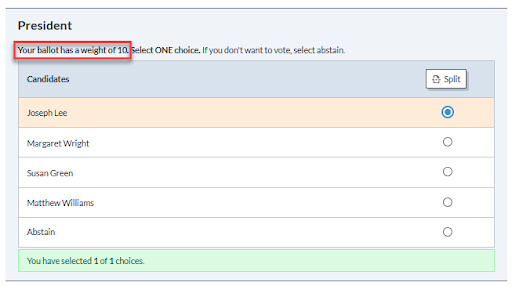For some organizations, especially within cooperatives or company shareholder meetings, voting power for each member or shareholder isn't always equal. Some may hold more "weight" or influence based on predefined rules (like shares owned, membership level, properties owned or proxies held).
One such method that handles this dynamic is Split Weight Voting. This allows the vote holder to split their weights between choices on the ballot. For example, if a vote holder has 3 votes, 1 of their own and 2 from receiving 2 proxies, on a yes/no motion they will have the ability to split the vote between yes and no, (ex. 2 votes yes and 1 vote no).
Each voter has a weight, which identifies how many votes they control. For example, one voter might have a weight of 72 , while another has a weight of 1. Split Weight voting will allow voters to split their votes among the available choices based on the votes they control. Below are a couple of examples to illustrate the options: the voter experience.
In this example, there is a ballot that allows the voter to pick one candidate, and the voter has 10 votes.


This voter can either assign all 10 votes to 1 candidate, or split them across the candidates on the ballot. For example this can be used to reflect a directed proxy, or a wife wanting to vote differently from her husband for each of the properties they own.

In this example, there is a ballot that allows the voter to pick 3 candidates as there are 3 open positions on the board, and the voter has 10 votes. Each voter receives a total number of votes equal to their weight multiplied by the number of open positions (vacancies). The number of votes the voter has is their weight x vacancy, in this case 10 x 3 equals 30 votes. This voter can either pick 3 candidates or split the 30 votes across candidates.
With questions that have more than one vacancy (in this case multiple vacancies on a board), voters cannot assign all their votes to a single candidate, by limiting the number of votes for each candidate to the weight the voter holds. For example, if a voter has 10 votes, a candidate cannot be assigned 11 votes. This allows the voter to allocate votes to all candidates. This function also prevents the voter from stacking all their influence on one candidate. Stacking their votes exceeds the number of votes they actually hold per choice.

Please note that this feature is only available for Plurality votes.
This voting style balances the need for weighted influence (important in shareholder or delegate-based environments) with fairness in distribution. It encourages voters to spread their preferences while still honoring the weight of their vote. It's particularly useful in multi-seat elections where strategic diversity is desired.
As well, this voting style works well for directed proxies. This means that one voter who holds multiple votes, can vote differently. For example, on multi-vacancy votes if they hold 10 votes, and 9 are proxies, this voting method allows the proxy holder to select different options based on the proxy givers preferences. This happens while ensuring the proxy holder can’t place all votes towards one option only.
This also addresses the issues with cumulative voting, where votes can be stacked or exceed the number of choices, which is especially important in multi-vacancy votes where a voter is voting on multiple open positions.
Try it out by creating a free account. Or, if you have questions, reach out by using the Buddy chat window in the bottom right-hand corner, or email support@electionbuddy.com. We are here to help!